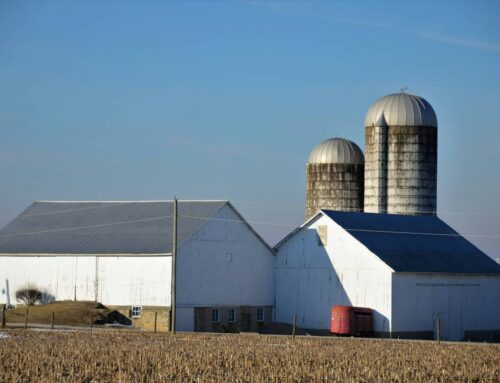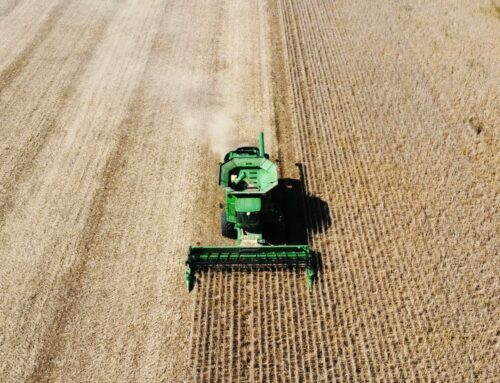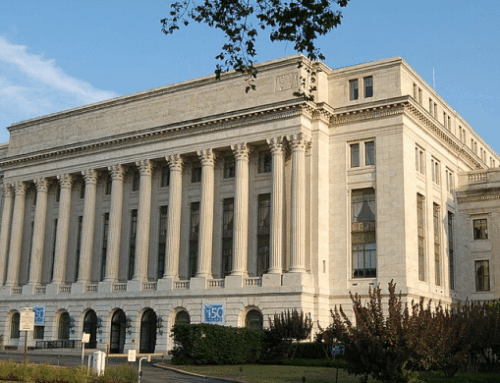Like all businesses, agricultural producers face a number of risks in maintaining a profitable enterprise.
Successful management of these risks is what separates thriving endeavors from failed businesses. Helping producers manage these risks has been a stated goal of federal policymakers for decades and taxpayers spend billions of dollars every year on various federal programs to this end. With the expiration of many federal farm programs in 2018, Washington must grapple with what role the government should play in managing and influencing American agriculture by helping agricultural producers manage risk.
A basic truth for all industries, including agriculture, is that most risks can be managed as part of a normal business strategy employing opportunities both on the farm and in the marketplace. Some risks, however, can be viewed as dangerous and disruptive or impeding other societal goals. With the federal pocketbook, policymakers in Washington have demonstrated how they do not fully trust the free market to manage all of the risks associated with agriculture. It is critical, however, that any government intervention in the market occurs only where there is a demonstrated need, and it does not simply crowd out private solutions while picking winners and losers between or even within industries.
An often repeated line is that agriculture is uniquely at risk from forces beyond its control, namely pests, disease, and the weather. But these risks can also be confronted with a number of unique risk management tools not readily available in other industries. The key, then, is to ensure that the government’s role in managing risks faced by agricultural businesses is relegated only to those risks that individual agricultural businesses and the market are incapable of successfully managing.
This is a brief examination of the risks American agriculture faces, how agricultural businesses can manage these risks, and the role of government in this heavily subsidized arena.
Risks Faced by Agriculture
According to the U.S. Department of Agriculture (USDA), there are five types of risk faced by agricultural producers: financial risk, human or personal risk, institutional risk, price or market risk, and production risk.
|
Types of Risk Faced by Agricultural Businesses |
|
|---|---|
|
Financial Risk |
Financing operations with debt creates an obligation to repay. Interest rates, collateral requirements, and the willingness of lenders to loan, all impact the bottom line of a business. |
|
Human or Personal Risk |
Agricultural businesses can be impacted by death, injury, sickness, divorce, or dissolution of partnerships. |
|
Institutional Risk |
Changes in governmental regulations and policies can impact profitability. |
|
Price or Market Risk |
The final price for a crop can vary between producers, location, and time. The cost of inputs (fertilizer, seed, labor, etc.) varies, as well. |
|
Production Risk |
Growth rates of crops and animals are uncertain. Variables outside of direct producer control, such as weather, disease, and pests, also impact production. |
Every business or individual faces financial risk—any time you take a loan or make an investment you bear a financial risk. While the direct risks vary between industries and lifestyles, every human also faces personal risk because of the possibility one will be injured or die, thus unable to earn a living. Institutional risk also affects everyone. It is impossible to predict how tax laws, and governmental regulations or policies will change, impacting one’s business or individual financial position. Price or market risk is also not unique to agriculture. Volatile input prices—the costs a business must pay for the materials, parts, and labor to produce a good or service—affect many industries. The price of petroleum, a very volatile input, is one of the largest determinants of cost for manufacturers. And agricultural commodities (i.e. corn) are themselves inputs that have a large impact on businesses, like food processing companies.
Agricultural price or market risk involves uncertainty about the prices producers receive for the crops they grow and the cost of resources (inputs) needed to produce these crops. Specific inputs vary depending on the particular crop a producer chooses to pursue. Fertilizer, seed, and gasoline, as well as equipment, land, and labor, electricity for irrigation pumps, medicine and feed for animals, are all costs that can impact a producer’s bottom line. As any consumer knows, some of these, like gasoline, have costs that can vary considerably even over a short period. Producers also face the risk of their products’ final purchase price being variable. How much a consumer is willing to pay for a bushel of corn today may not be the same as what he will pay tomorrow.
Production risk centers on the natural variability in the quality and quantity of a farm business’ product. There is an element of risk in the natural growth processes of crops and livestock. In addition to the variability of genetic traits, some hogs get fatter faster, production risk involves such impacts as weather, disease, and pests. All of these elements, which aren’t directly controlled by a producer, impact the amount and quality of product harvested.
It is the details around price or market risk, as well as production risk, that many claim separate agriculture from every other type of business. This perceived uniqueness serves as justification for policymakers in Washington to create complicated and costly interventions into the risk management decisions of agricultural businesses. But agricultural producers also have access to a diverse set of tools to manage their risk, often requiring no direct financial support from the government.
Risk Management in Agriculture
Agriculture is the world’s oldest industry. Consequently, successful risk management strategies have been employed for millennia. Most modern agricultural businesses utilize a number of these time-tested strategies for maintaining a successful enterprise. The Department of Agriculture’s Economic Research Service describes the various Risk Management Strategies on their website.
| Risk Management Tools for Agricultural Businesses | |
| Diversification | Growing more than one crop. Raising crops as well as livestock. Prices for some crops may rise while dropping for others. Pests, disease, and weather impact different crops as well. |
| Financial leverage | Loans and lines of credit allow businesses to use their assets to take advantage of business opportunities and increase cash flow. |
| Vertical integration | Maintaining control across more than one phase of production or marketing. For example, growing corn to feed to one’s cattle. Or owning a processing facility as well as raising the agricultural product. |
| Liquidity | Maintaining cash reserves. Managing investments in machinery, land, and other inputs. Storing crops to sell at a later date. |
| Contracting | When a producer and a purchaser agree to exchange a product at a guaranteed price, amount, and quality (forwarding). Can also apply to the purchase of inputs or production methods (production contracts). |
| Hedging | Using market futures and options to lock in price. |
| Household off-farm employment or investment | Supplemental income from other than on-farm activities. |
| Private Insurance | Most common for hail protection. |
| Federal Entitlements | Highly-subsidized federal crop insurance, direct payments, counter-cyclical payments, loan deficiency payments, storage payments, price supports, disaster assistance, direct purchasing, and conservation payments are all forms of direct federal involvement in agriculture that mitigate the risks of doing business.
Marketing loan assistance, taxpayer financed research, rural development grants, and trade assistance programs also include federal dollars reducing the costs of business for the agriculture sector. |
Agricultural businesses face numerous risks in producing profitable businesses. They also have a diverse set of strategies to manage these risks. The key question then is whether and when government should intervene in the market to aid producers in managing their risk. To determine this, one must examine another dimension of risk, the level of risk.
Risk Levels for Agricultural Businesses
Risks that define the typical bounds faced by a business are normal risk. In agriculture typical variations in production, prices, and weather are normal risks. How an individual business navigates the normal risks of business—by choosing what crops to plant, when to plant, management decisions on and off farm—separates efficient producers from inefficient producers.
The second layer is marketable risk. Markets have produced numerous ways of bringing people who want to take on risks (for potential larger profits) with people who want to lay off risk (for predictability of profits). Contracting, vertical integration, a robust securities market, marketing cooperatives, and private insurance, are all market mechanisms that producers can choose between to manage their risks.
Finally, there are risks that impact large numbers of people across large areas and are, for the most part, beyond the control of any one producer and challenge the capacity of even a well-functioning market. These are catastrophic risks. Floods, widespread drought, and disease outbreak can be catastrophic risks. However, some argue that even catastrophic risk can be insurable (and in some ways would be easier to price than lesser levels of coverage).
Governmental Role in Risk Management
The near consensus in Washington is that, despite the diverse set of tools available, agricultural risk management cannot be left up to individual producers and the free market. Consequently, a myriad of taxpayer financed programs exist and impact the risk management strategies of agricultural businesses. But contrary to popular political belief, subsidized insurance can actually promote risk-taking such as growing crops inappropriate for the climate or planting on marginal land because farmers are able to lay off the majority of risk to the taxpayers.
Highly-subsidized federal crop insurance, commodity specific “shallow loss” programs, loan deficiency payments, commodity storage payments, price supports, disaster assistance, direct purchasing, and conservation payments are all forms of direct federal involvement in agriculture that mitigate the risks of doing business for various agricultural producers. Subsidized loans , taxpayer financed research, rural development grants, and trade assistance programs also include federal dollars reducing the costs of business for the agriculture sector.
In the current Farm Bill debate, many advocate increasing even further the federal role in agricultural risk management. The federal crop insurance program currently has taxpayers in the business of managing marketable risks by subsidizing, on average 62%, premiums charged to producers for purchasing insurance policies that often protect up to 75% of expected revenue. In addition, the 2014 Farm Bill expanded the taxpayer role even further by creating “shallow loss” and target price programs that make payments to agricultural producers for dips in anticipated revenue too shallow, as little as a 10% loss of expected revenue, to trigger payments under crop insurance. This is despite the existence of a burgeoning fully private “shallow” loss industry that would be wiped out by creation of a new federally subsidized program.
Conclusion
If government is to have a role in supporting risk management for agricultural producers, it should focus on catastrophic risks that the market is incapable of protecting against. The current agricultural safety net protects against more than simply catastrophic losses.
Shallow loss programs created in the 2014 Farm Bill, including Agriculture Risk Coverage (ARC), Supplemental Coverage Option (SCO), and Stacked Income Protection Plan (STAX)— have increased the government’s role in individual producers’ risk management decisions and expanded to cover even shallower losses than previous programs. Government’s role is not to protect parochial concerns at the expense of national interest; and not to protect producers from normal or marketable risks.
With record national debt and annual federal deficits on the rise, now is the time to reform federal agricultural policy to create a cost-effective, transparent safety net for agricultural producers that is responsive to current needs and conditions, and in which all parties are held accountable for producing results benefitting the public interest. Focusing federal risk management policies on catastrophic risks, instead of normal business risks, is a critical first step.










